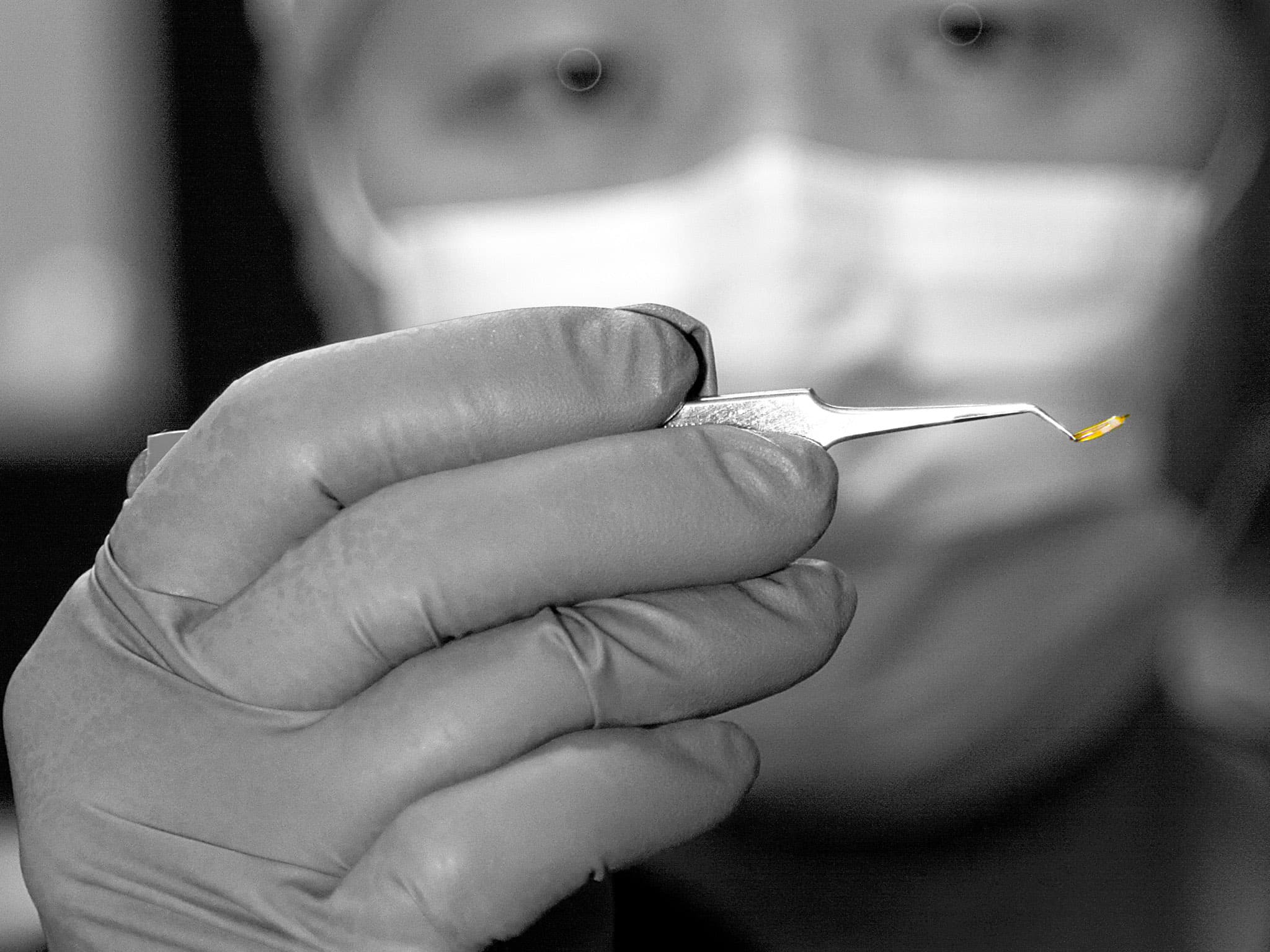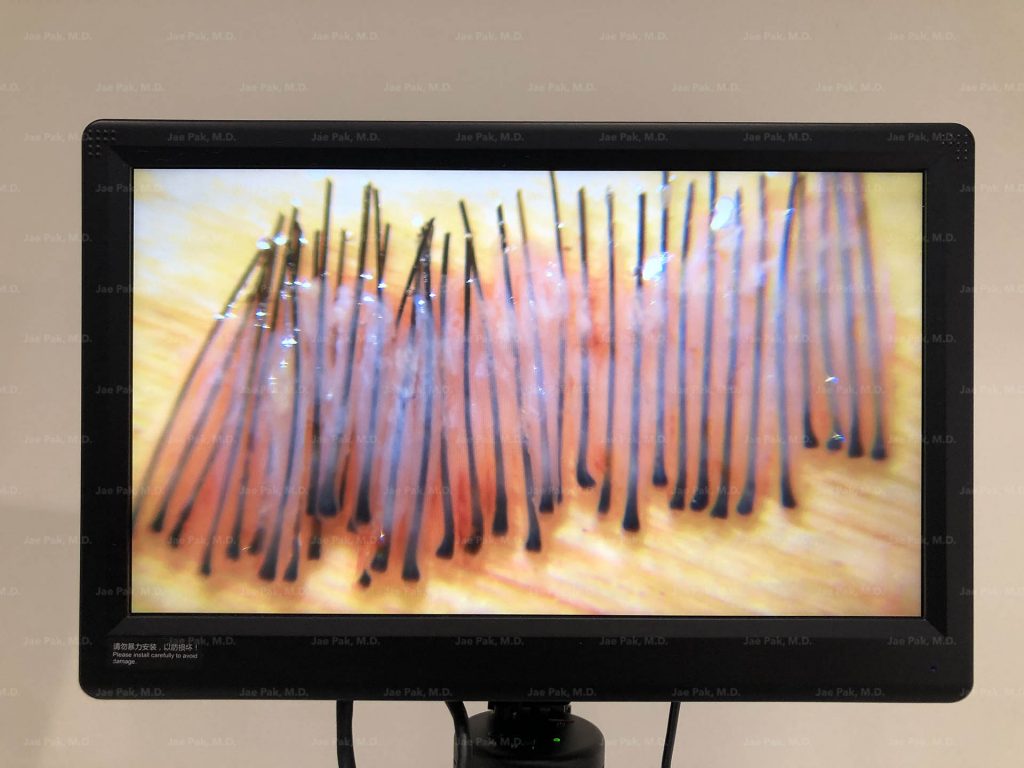
Picture of Dr. Jae Pak holding a hair graft.
A hair transplant doesn’t happen all at once. Instead, surgeons and technicians operate slowly and steadily, one move at a time.
The goal is grand in scope: restore a healthy and aesthetic head of hair. However, the focus at any given moment is far more singular.
Hair grafts are the small pieces of the puzzle that come together, creating a masterpiece!
Whether you choose to undergo FUT strip surgery or any other type of specialty treatment, it’s all about hair grafts. These are the individual units of interest for hair restoration experts – the bulk of their efforts goes into harvesting, protecting, and transplanting these grafts, one by one.
There is so much that goes into the extraction, dissection, and implantation of hair grafts. Understanding these steps will give you a deeper appreciation for what goes into the hair transplant process overall.
Plus, these findings will help you gain more insight into hair transplantation’s technical expertise and artistry and what separates top-tier surgeons from the rest. Let’s begin exploring hair grafts, how they work, and what they mean for your results.
What do we really mean when we talk about hair grafts?

To a hair restoration specialist, a hair graft is best defined as a hair follicle containing one-three healthy hairs. These grafts can be taken from anywhere on the body and used to achieve a wide variety of medical or cosmetic objectives.
In the context of surgical hair transplantation, of course, we view hair grafts as the building blocks of a restoration procedure to add greater density and coverage to a target area, whether it’s the scalp, the temples, the eyebrows, facial hair, or anywhere else desired.
Just how big is the typical hair graft, and what shape do they take under a microscope?
If you were to zoom in on the average graft, you’d notice that it’s not a particularly substantial piece of tissue. In most cases, a graft is no more than one centimeter in length, containing an average of two or three hairs in a single unit.
You will also notice the depth of the follicle units (the hairs themselves) seated within the fatty tissue extracted from the donor area. This tissue may be clear or slightly translucent in appearance, sometimes with a bit of blood on the exterior.
As we’ll explore shortly, there are several ways to obtain these grafts and a wide array of techniques used to dissect and ensure the survival of the follicular units within.
Strong and structurally sound hair grafts are invaluable to the hair restoration technician and the surgeon coordinating the procedure, whatever it may be.
In the case of a traditional hair transplant for androgenetic alopecia (male pattern balding), anywhere between 1,000 and 3,500 grafts may be required for a single session. Over a lifetime, up to 8,000 hairs can be moved from the donor area of the scalp to the recipient area!
Other popular procedures focus less on the sheer quantity of these grafts instead of the shape, curvature, and quality of the hairs contained.
Look at innovations in eyebrow transplant surgery, for instance, to see how donor hair is carefully chosen to adhere to the brow’s natural shape. Not to mention, create natural, aesthetic results that grow and behave just as real eyebrow hair would.
This tells us that there is a wide range of quality and unique characteristics found in hair grafts, even if they originate from the same donor region.
Surgeons find great variation in terms of size, shape, strength, depth, and even color in the donor area, leading them to make difficult aesthetic and technical decisions during the intense surgical process.
Time is of the essence, and there is no substitute for experience and technical ability during these high-pressure procedures.
Simply extracting and implanting hair grafts is not enough to ensure top-notch results for hair transplants or other procedures of this kind.
Here are some factors that come into play when processing hair grafts from the beginning to the end of the surgical process.
This is the most common type of hair transplant for patients requiring high volumes of grafts to be transplanted in a single sitting, also known as a FUT mega session.
The advantage here comes from the substantial portion size yielded by a long, horizontal strip of skin from the donor area, containing many thousands of potential grafts of exceptional quality.
Surgeons and technicians have the luxury of being more selective when dissecting and implanting hair grafts and can generally extend the lifespan of these grafts as they sit outside the body, typically fortified with a medical-grade solution.
From there, techs will provide surgeons with high-quality grafts to then be implanted to the recipient area, with less concern for damage,transection, or low survival rates.
An increasingly popular procedure known as Follicular Unit Excision targets individual hair grafts and immediately implants them to the recipient region.
This puts greater pressure on the surgical team to move quickly, and higher transection rates have been recorded due to decreased survivability of isolated hair grafts from FUE.
However, methods are improving with time, protecting hair grafts in the interim and giving surgeons more breathing room to make intelligent and deliberate decisions for implantation, rather than being rushed or limited by technology.
What is the purpose of studying hair grafts and the science behind them?
Aside from being a fascinating subject, a better understanding of hair grafts will help you make the best decision for your hair restoration needs, whether it’s seeking natural treatments, medication, lifestyle changes, or hair transplantation surgery.
If you decide that a procedure such as FUE or FUT is, in fact, the best choice for your circumstances, consider the points we’ve made thus far and factor them into your final decision.
Here are some final points to keep in mind as they impact your follicles, the grafts they yield, and the overall outcome of your procedure.
Depending on which clinic you attend for your hair transplant procedure, different methods and technologies will be used to harvest, dissect, and implant the individual grafts from the donor area.
Even small variations in approach can lead to drastically different results.
For this reason, you’ll want to make sure your surgeon of choice has a deep and studied understanding of how hair grafts work. Look to see if the surgeon has made technological advancements or innovations in the field of hair transplantation.
Browse the web for medical papers and studies that show the surgeon has a depth of knowledge and command over the technology they employ.
These are sure-fire signals that a surgeon – and the staff that support them at the clinic – are well equipped on a technological and cognitive level to take on the most challenging hair transplant procedures and deliver on their promises.
In the weeks and days leading up to your hair transplant, you’ll need to do your part in ensuring that your donor hair is healthy and ready to survive the harvesting and implantation process it’s about to endure.
This might mean coming off certain medications, limiting vices like alcohol or smoking, getting more physically active, or boosting your diet in terms of nutrition and hair-healthy supplements.
Aftercare following the surgery is an even greater responsibility – don’t skip the instructions given by the clinic and take no shortcuts to ensure that grafts take root in a healthy manner.
Like the points in an impressionist painting or stones in an old-world cobbled street, every single hair graft plays a vital role in the overall results of a hair transplant, eyebrow transplant, or any other type of procedure involving the extraction and implantation of these grafts.
As we’ve discovered, many factors come into play when extracting these grafts with various techniques and technologies.
Ultimately, your surgical team’s experience and expertise make the biggest difference at the end of the day. If you’ve only just begun your search for a hair restoration clinic, keep in mind what we’ve covered in this article.
When you’re ready to take the first step on the path towards a full and healthy head of hair, please reach out to schedule a consultation with the one and only Jae Pak, MD. We look forward to speaking with you and mapping out a strategy for success!
Sources:
Speak with Jae Pak, M.D. today!
Request a Consultation